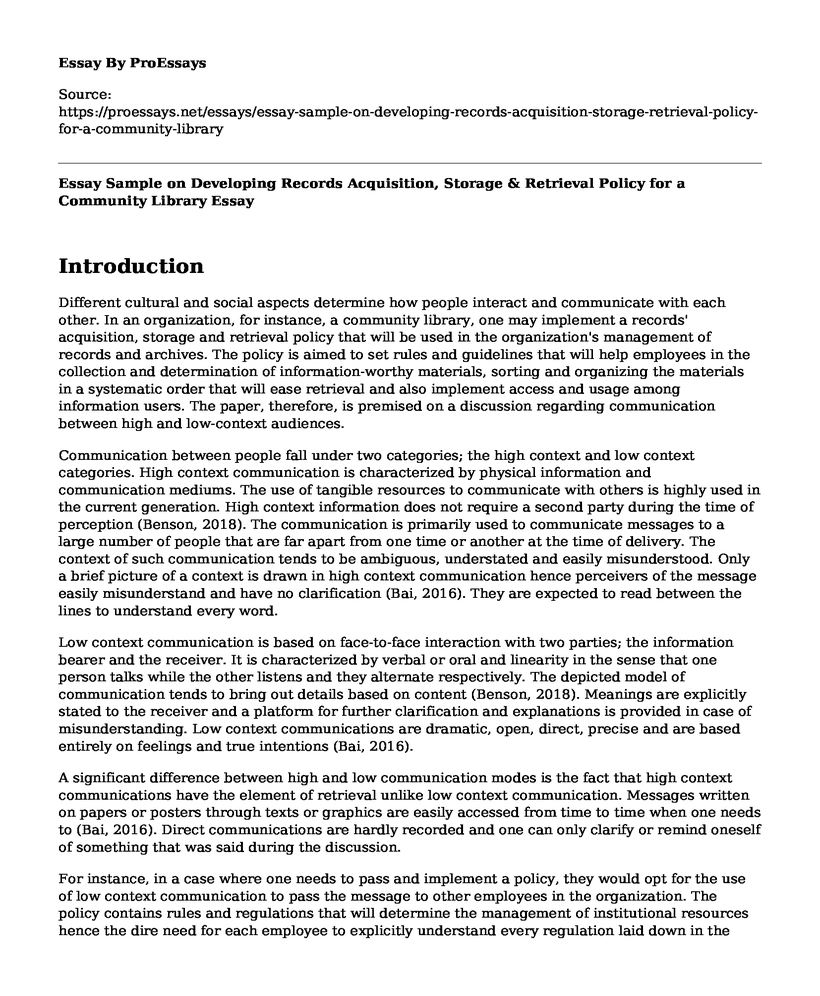Introduction
Different cultural and social aspects determine how people interact and communicate with each other. In an organization, for instance, a community library, one may implement a records' acquisition, storage and retrieval policy that will be used in the organization's management of records and archives. The policy is aimed to set rules and guidelines that will help employees in the collection and determination of information-worthy materials, sorting and organizing the materials in a systematic order that will ease retrieval and also implement access and usage among information users. The paper, therefore, is premised on a discussion regarding communication between high and low-context audiences.
Communication between people fall under two categories; the high context and low context categories. High context communication is characterized by physical information and communication mediums. The use of tangible resources to communicate with others is highly used in the current generation. High context information does not require a second party during the time of perception (Benson, 2018). The communication is primarily used to communicate messages to a large number of people that are far apart from one time or another at the time of delivery. The context of such communication tends to be ambiguous, understated and easily misunderstood. Only a brief picture of a context is drawn in high context communication hence perceivers of the message easily misunderstand and have no clarification (Bai, 2016). They are expected to read between the lines to understand every word.
Low context communication is based on face-to-face interaction with two parties; the information bearer and the receiver. It is characterized by verbal or oral and linearity in the sense that one person talks while the other listens and they alternate respectively. The depicted model of communication tends to bring out details based on content (Benson, 2018). Meanings are explicitly stated to the receiver and a platform for further clarification and explanations is provided in case of misunderstanding. Low context communications are dramatic, open, direct, precise and are based entirely on feelings and true intentions (Bai, 2016).
A significant difference between high and low communication modes is the fact that high context communications have the element of retrieval unlike low context communication. Messages written on papers or posters through texts or graphics are easily accessed from time to time when one needs to (Bai, 2016). Direct communications are hardly recorded and one can only clarify or remind oneself of something that was said during the discussion.
For instance, in a case where one needs to pass and implement a policy, they would opt for the use of low context communication to pass the message to other employees in the organization. The policy contains rules and regulations that will determine the management of institutional resources hence the dire need for each employee to explicitly understand every regulation laid down in the policy (Bai, 2016). Most people prefer the method as it is generally interactive and helps create a personal relationship with another. The action will, thus, provide a conducive work environment with employees knowing what guides them with the know-how of the business in the organization (Bai, 2016).
Conclusion
Methods of communication, such as video and audio recordings, apply to both high and low context audiences. Detailed content is given by an instructor who may use both written text and graphic illustrations to deliver a point. Well explained recordings reduce the need for clarifications or further explanations (Benson, 2018). They can also be stored and watched or listened to at a later date.
References
Bai, H. (2016). A cross-cultural analysis of advertisements from high-context cultures and low-context cultures. English Language Teaching, 9(8), 21-27. Retrieved from https://eric.ed.gov/?id=EJ1103456
Benson, S. (2018). High Context vs. Low Context Political Messages and Audience Preference (Doctoral dissertation). Retrieved from https://our.oakland.edu/handle/10323/4779
Cite this page
Essay Sample on Developing Records Acquisition, Storage & Retrieval Policy for a Community Library. (2023, Mar 27). Retrieved from https://proessays.net/essays/essay-sample-on-developing-records-acquisition-storage-retrieval-policy-for-a-community-library
If you are the original author of this essay and no longer wish to have it published on the ProEssays website, please click below to request its removal:
- The Racial Contract - Essay Sample
- Communication Case Studies for Health Care Professionals Paper Example
- Teenage Depression Essay Example
- Essay Example on Music: Gender and Ranking Roles in a Discriminatory World
- Essay Example on Chaucer on Women: Obedience & Virgin Mary
- Paper Example on Teenagers' Bone Strength: The Role of Hormones
- Paper Example on Age-Related Changes: Nutritional Challenges & Health Risks







